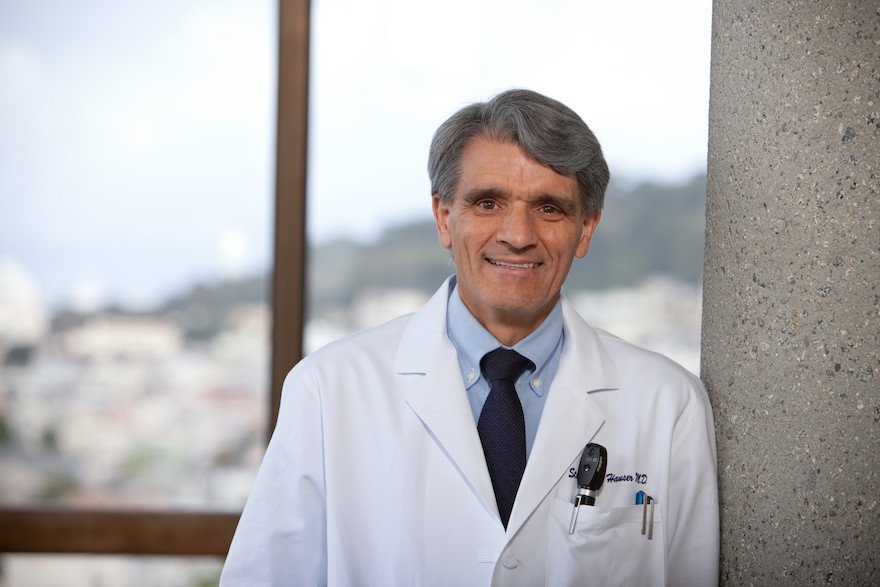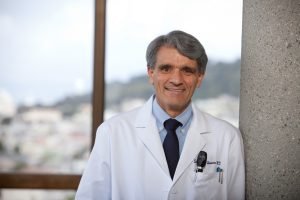UCSF Neurologist Played Key Role in MS Research Turning to B-Cells, Essential Step to Ocrevus

Dr. Stephen Hauser was instrumental in the development of Ocrevus.
Dr. Stephen Hauser, chair of the neurology department at the University of California San Francisco, was instrumental in the early research and later clinical trials that ultimately led to Ocrevus (ocrelizumab), the first therapy approved by the U.S. Food and Drug Administration (FDA) for both relapsing MS (RMS) and primary progressive multiple sclerosis (PPMS) patients.
Indeed, his work is testament to how scientific inquiry and determination might turn observations made in the lab into medicines for those in need.
Ocrevus is an antibody that targets CD20-positive B-cells, a type of cells from the immune system that are believed to contribute to myelin degeneration and neuronal damage, the hallmarks of MS. As such, and because of the efficacy and overall safety demonstrated in those clinical studies, Ocrevus holds considerable promise as an MS treatment — and one that might help at least some people with progressive disease.

Dr. Stephen Hauser was instrumental in the development of Ocrevus.
“The availability of a highly effective and well-tolerated treatment means that people at the dawn of their MS can be treated with a therapy that will essentially completely block the inflammation in myelin that causes relapses and remission,” Hauser said in a UCSF news story, reported by Nina Bai, on which this article is based. “And we are optimistic that by doing so, the outlook over many years will be even more favorable than it is today.”
Early steps and obstacles
The development of Ocrevus took several decades and encountered many obstacles along the waym Bai writes. For instance, when Hauser and his research team were trying to secure funding to study a drug that inhibited B-cells, the National Institutes of Health (NIH) told them their proposal lacked “biological plausibility.” Back then, T-cells (another type of immune system’s cells) were widely believed to be the major contributors to MS development.
But Hauser and his team felt they were on the right track when — while studying MS pathology using their own mouse model of the disease in the mid-1990s — they detected antibodies “tightly bound” to proteins in damaged myelin. These were the same antibodies found in samples of spinal fluid from patients, and which widely were used as biomarkers for MS although not considered to have a role in disease mechanisms.
The team also discovered that MS could be induced in healthy animals by transferring these antibodies and B-cells, as well as T-cells. This showed that these antibodies, which not many people seemed to care much about, were actually partners in crime — alongside T-cells — in causing MS.
“This was a paradigm change for the field,” said Hauser, though it would take another few years before he, too, would look beyond T-cells, Bai reported.
Hitting the nail on the head
Hauser and his team asked the NIH to support work testing whether an existing cancer drug called rituximab, which targets B-cells and is B-cell lymphoma, could inhibit the production of the antibodies that caused inflammation in MS. The NIH wrote back, suggesting the researches refocus on T-cells.
“We were devastated,” Hauser told Bai. “But we were not ready to quit.”
Hauser and colleagues then talked to Genentech, the company that developed rituximab, and the two eventually agreed on a small test of the drug’s effects on antibody production. The antibodies are not directly produced by B-cells, but by intermediate cells not directly targeted by rituximab, so the researchers expected several doses would be needed for an effect.
They were wrong — one dose was enough. “There was an almost immediate and nearly complete blockade of all new inflammation in the people who had received the drug,” Hauser said in the interview.
The surprise result was valuable, telling the researchers not only had they hit upon a discovery that “was likely to help many hundreds of thousands of people,” but also that “the science that had driven the experiments was wrong.” In other words, these results suggested that the antibodies were not the trigger for the damage being seen to the myelin sheath of nerve cells in MS patients, but B-cells themselves, because antibodies take longer to control.
Years later, Genentech (now part of Roche) developed ocrelizumab to specifically target CD20 B-cells in ways the company considered best for patients. Ocrelizumab, unlike rituximab, is a humanized B-cell antibody, and offered “the best potential for efficacy and safety in people with MS, a disease where long-term treatment is warranted,” Dr. Peter Chin, a neurologist and principal medical director of Global Neuroscience Development at Genentech, said in an interview with Multiple Sclerosis News Today.
The development marked the beginning of the clinical program that culminated with Ocrevus’ approval on March 28.
Hauser concluded the UCSF interview with these words: “My hope is that ocrelizumab will make a life-changing difference for many hundreds of thousands of people with MS today, and many more who may develop MS in the future.”
A UCSF video with Stephen Hauser discussing MS and his research into B-cells and their role in the disease is available at this Facebook site, and open to all viewers.
More on Ocrevus’ history and the clinical trial results that led to its approval is available via those links, and columns expressing patients’ views can also be found at Multiple Sclerosis News Today.






